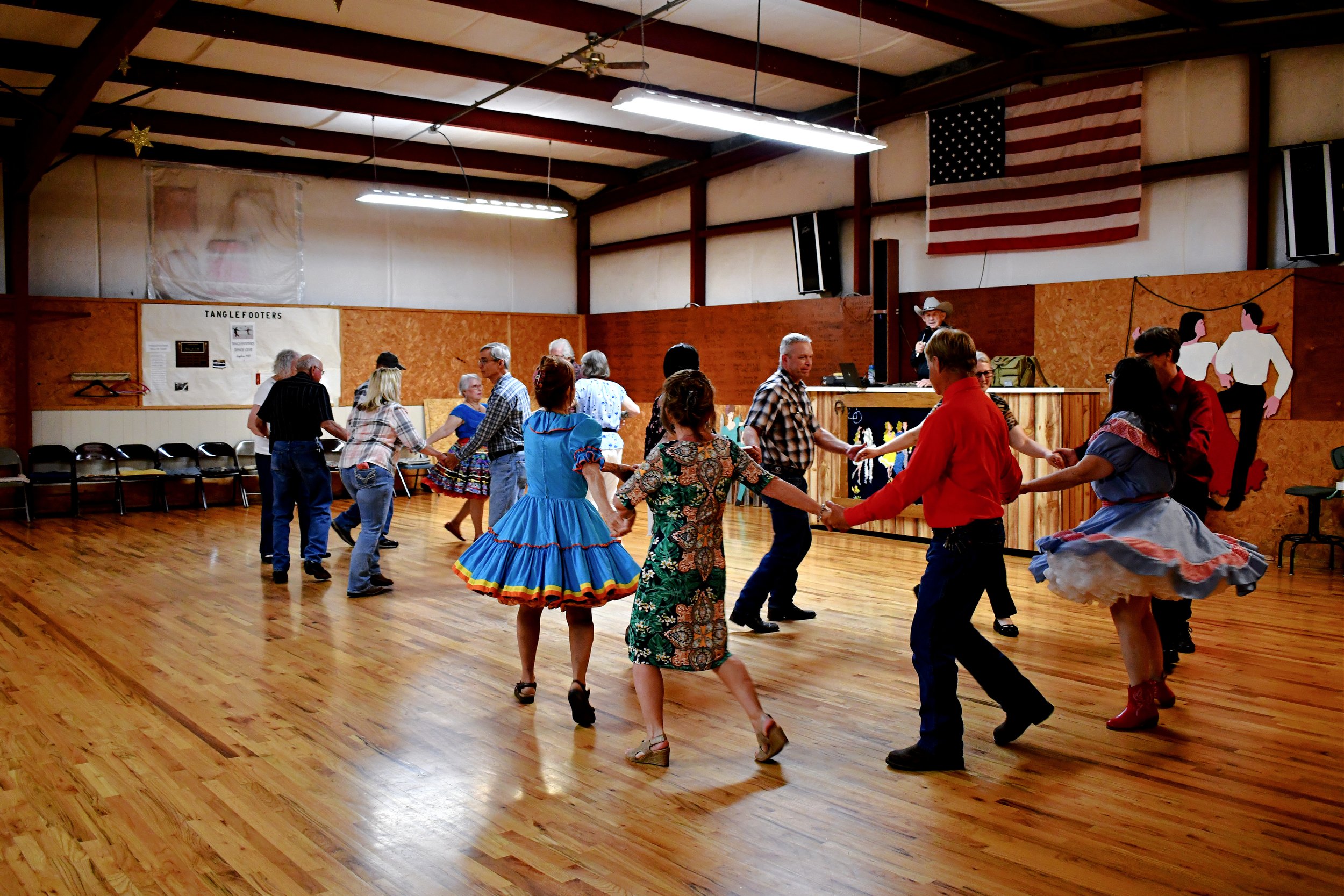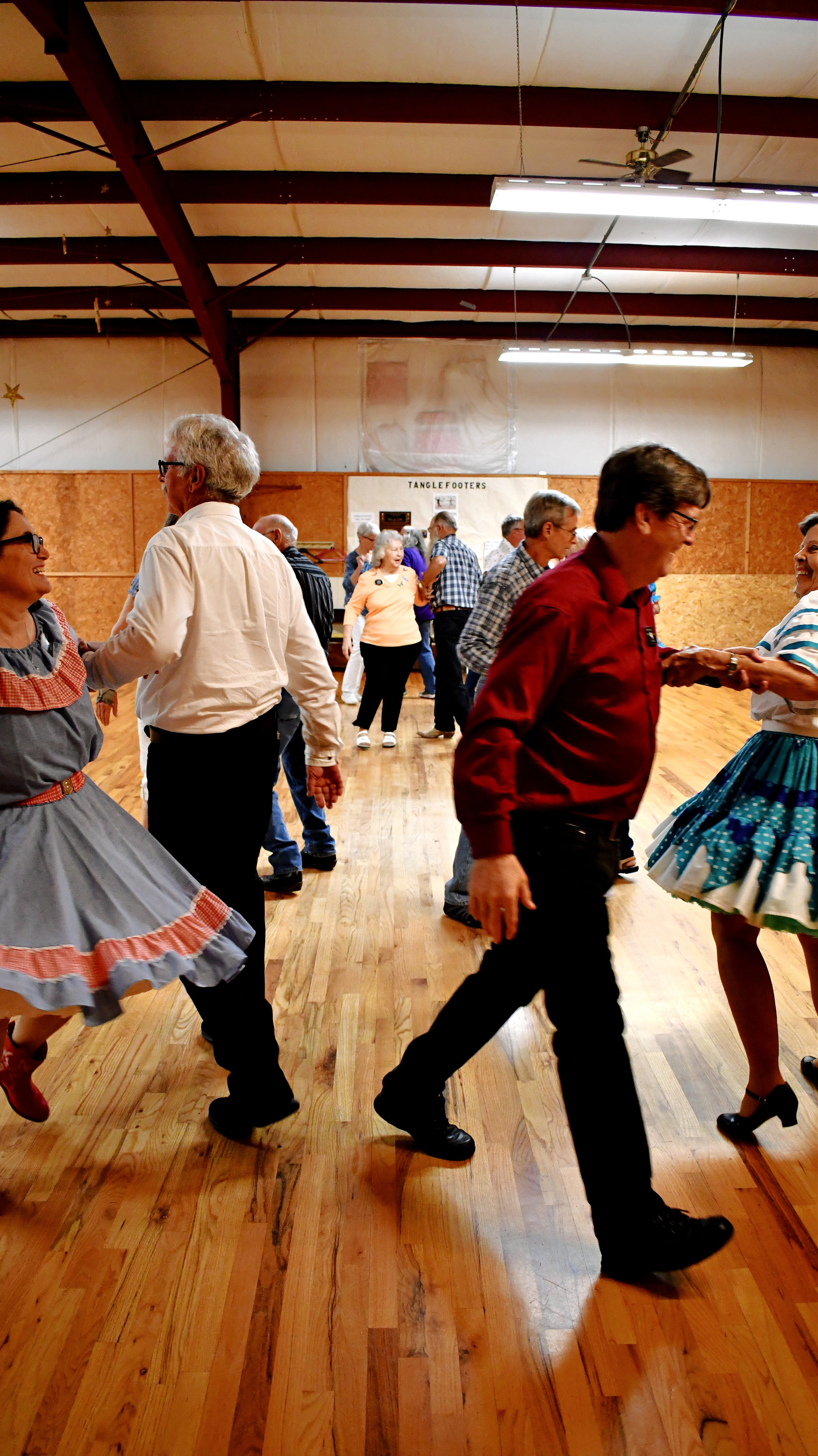Joplin’s Western Twirlers Square Dance Club spins since 1948
Western Twirlers Square Dance Club in Joplin meets to dance on the first Saturday of most months.
JOPLIN - The Western Twirlers Square Dance Club has become the oldest of its kind in Missouri by going in circles – and squares and lines and so many shapes – since 1948.
Now 75 years since its start, the club’s members – some who date back decades – bond over a shared interest in the fun found through square dancing. As a result, it also helps keep the tradition alive.
“We get basically a little bit of the four-state area,” says Shirley Winans of Webb City, the group’s secretary, who has been involved in the club since the 1980s. “At one time, Joplin had four clubs, but we’re the only one left.”
Instead of casual square dances in barns and homes of old, these dances are the result of weeks of classes which are required before individuals become club members.
“I don’t think a lot people know what square dancing is,” explains Winans. “They don’t realize it’s synchronized and everyone’s doing the same thing.”
While square dancing does require a partner, the dances also provide a way to meet other people. An example is Clyde Lowe, who met his wife at a square dance more than 30 years ago. But it’s also a way to make friends and form a sense of community.
“There are so many nice people who you meet here,” says Doris Donham, the chapter’s president, who began dancing in 1978 in her 30s. She’s been involved ever since.
Western Twirlers began at a time when square dancing was much more well-known and practiced in the region than it is today. Lowe, 78 years old, puts it this way: “I was born into square dancing.”
According to the Square Dance History Project’s website, “Square dancing has been an integral part of American social life for centuries. Traditional square dance was vital for generations of Americans, especially in rural communities; in the post-World War II era, modern square dance similarly enjoyed participants numbering in the millions.”
That time was when Western Twirlers officially began. The next decade saw the start of the Missouri Federation of Square & Round Dance Clubs, which still provides an umbrella organization for square dance and round dance clubs. The latter, a form of synchronized ballroom dancing, also manifests at the Joplin center though the Tanglefooters Round Dance Club, which meets on Mondays.
Winans serves in many circles, even away from the dance floor: She’s secretary for Western Twirlers as well as for the Missouri federation’s southwest district, and on the state level as a delegate, and on its promotions committee. The organization offers a unifying foundation for the clubs across the state, a number which includes several in the Ozarks.
These clubs represent change from square dances that often drew dancers to rural homes and barns in the Ozarks.
Today, dancers take lessons before they join the club. What they’re taught ties back to the 1970s and the creation of CALLERLAB, an organization dedicated to providing training for callers and the standardization of calls, or what some might think of as steps.
Other changes include call complexity, which is greater today than it was in the past. Instead of a caller in every square, modern amplification allows one person to lead the entire room.
Additionally, caller’s chants and dancers’ feet move to modern music, not necessarily old-time fiddle tunes once heard at Ozarks square dances – although some styles are easier to dance to than others.
“I can’t say I like dancing to rap,” Lowe says.
Caller Jay Wright stands in the back of the room and calls dances from a platform.
As the dance begins, caller Jay Wright goes up to the back of the Joplin Square Dance Center – constructed in the early 1980s as a dedicated home for the club and other local dancers — and stands on a platform. Laptop at the ready, he welcomes dancers to the floor for the first “tip,” or set of two songs. Both are set to music, but the first is simply called to an instrumental tune and the second he sings.
“What I’m going to do tonight: We’ve got kind of a mixed crowd, so I’m going to do a mainstay tip, then a basic tip, then we’re going to a plus tip, and then mainstream,” Wright says of varying skill levels from the platform’s microphone.
Women in colorful, ruffled skirts and voluminous petticoats — a holdover from earlier days that aren’t as common as they once were — take the floor alongside partners, all who begin to spin, twirl and move in time with each other and to Wright’s chants.
“There's like 69 different calls to the program that we normally dance to. You learn the call, and that’s what you do every time you do that call. But you can mix and match the calls however the mood strikes the caller to do,” says Wright. “The dancers don't know the sequence. They know the calls but they don't know the sequence that the caller’s going to give them to them. Which is really the biggest intrigue about the whole thing; what's coming next.”
Wright became interested in square dancing more than 40 years ago. It soon led to an effort to learn to call – and today, a regular presence at square dances across the Ozarks, one for years practiced alongside his day job in plumbing.
“I got introduced into square dancing when I was 30 years old,” says Wright, who grew up in northeast Missouri but moved to the opposite quarter of the state after finishing military service. “The guy who got me into this was after me for four years to go get square dance lessons; I said, ‘No, I’m not doing that.’
“I finally went and started taking the lessons. I really fell in love with it – it’s a very good activity. There was another guy there; he was taking dance lessons the same time I was, and one or the other of us said, ‘I want to do that – I want to learn how to call.’ We started together learning how to call. Scared to death; absolutely petrified to be in front of people.
Most of Wright’s skill was self-taught, although he did ultimately go to a course “to see what I was doing wrong, which was a lot,” he says. “I just kept doing it. Luckily, people would ask me to call. It just grew from there.”
Those efforts led to his induction into the Missouri Caller/Cuer Hall of Fame in 2009.
Jay Wright became a square dancer caller as a young adult, and was inducted into the Caller / Cuer Hall of Fame in 2009.
From Wright’s vantage point, he’s seen great change in the world of square dance. Although even today he still calls at several local dances, that number of occurrences has dwindled.
“It kind of started taking a decline, I’m going to say, at the turn of the century. In the late ‘90s, it started slowing down,” Wright says. “Then when COVID hit, it just wiped it out. But right now, it looks like we might get a turn around to kind of go back the other direction.”
While numbers of square dancing clubs have shrunk in Missouri — remnants of local clubs now gone hang on the walls of the Joplin center — the style of dance still sees popularity in other countries. Square dancing is done internationally, Wright says, and shares that it’s seeing great popularity in Japan.
“Even if the caller doesn’t speak English, he will call in English,” says Wright. “It’s bigger in Japan than it is in the United States right now.”
Most of Wright’s calling is done from a laptop, which contains lyrics and music in one place. However, he also still carries a turntable in case he wants to use it.
A potluck meal is part of the monthly dances.
After a break for a potluck meal, Wright goes back up to the platform and begins to call dancers and songs back to the floor. He shares the level of each before they begin; even though the steps are standardized, they can be used in intricate ways that make dances a greater challenge.
Dancers present on this particular night represent a range of experiences, both in life and years of dancing. There are folks like Elfriede Greenwood, whose late husband was Van Greenwood and a longtime caller for the club. There’s the aforementioned Clyde Lowe, who drove roundabouts 100 miles from Chanute, Kan., for the Joplin dance.
Then there are others like Roger and Bonnie Henady, who recently joined the club.
“We’re to the age where kids are raised, and this gives us something to do as a couple,” says Roger Henady, who began taking lessons a few months ago with his wife. “I just have fun doing it. They help you learn.”
Taking the floor
And it helps participants stay engaged and active.
“This is a great activity. It's good for your body; it's good to your mind,” says Wright. “You cannot come in here and get in a square and be worried about your car payment or sick kid or whatever has you troubled at the time. You’ve got to forget all this other stuff. It’s good all around.”
Want to learn more?
Click here to learn more about Western Twirlers Square Dance Club, and here to see a list of other clubs across the state of Missouri.
The creation of this article is underwritten by Show Me Folk, an initiative of the Missouri Folk Arts Program, and is published through a collaboration with Ozarks Alive.
Show Me Folk sustains our state’s folk arts and folklife in collaboration with Missouri citizens by identifying traditional arts regionally; documenting traditions locally; and sharing Missouri stories widely. Learn more about mofolkarts.missouri.edu.





